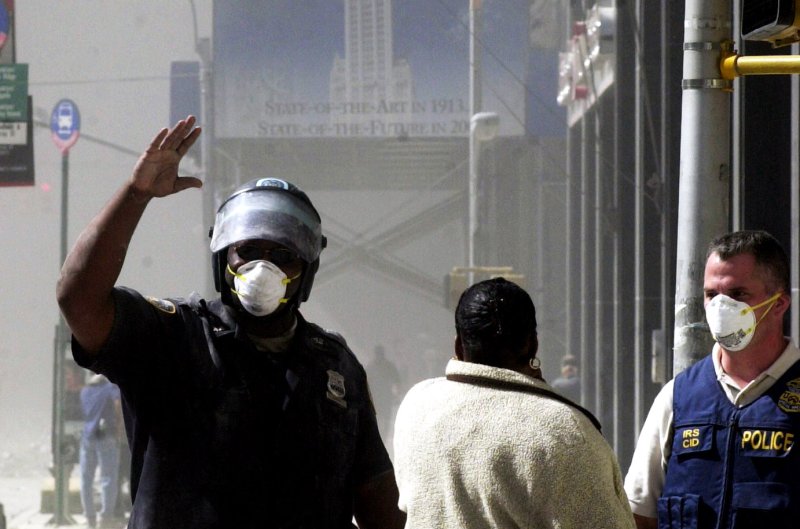1 of 9 | Police turn civilians away from the vicinity of the collapse of the World Trade Center twin towers in lower Manhattan after two hijacked commercial airliners deliberately crashed into the buildings on September 11, 2001. File Photo by Ezio Petersen/ UPI |
License Photo
On the 42nd floor of Tribeca Tower, four long caddy-corner blocks from One World Trade Center, the picture window rattled and the floor shook in the way that people describe earthquakes, but the sound was deceptive.
Louder than anything I've ever heard before in New York, it seemed like it had to come from below. I looked down for the car bomb or the demolition crew, but a second later a ball of flame shot out of the huge crater that used to be probably seven floors of One World Trade.
They got it. The terrorists got a bomb onto the high floors, I thought, where fire rescue is next to impossible.
It looked like a Hollywood miniature, something out of Independence Day, and it burned like the dickens. I watched it burn until I realized I was frozen, transfixed. I flipped on New York 1. Nothing yet. I switched over to CNN, where a commentator was saying that a "twin-engine plane" had crashed into the building. The image on the CNN screen was identical to the one through the picture window, but mine was infinitely more vivid.
The air was filled with crystal flakes, and the wind was carrying them eastward, toward Wall Street. What were they? Metal? Glass?
A twin-engine plane? I was staring into a fiery gash that cut diagonally through three-quarters of the building, and it's a huge building. Could a twin-engine plane do such a thing?
The CNN commentator talked about "navigational guidance systems." It seemed incredible. I waited for the words "terrorist" or "suicide bomber," but he was going on about "flight approaches to La Guardia."
A heavy black object fell straight down from the side of the building, and the smoke from the fire was forming a mushroom that was moving toward the tourist observation deck of the second tower. The plaza between World Trade Two and the Millennium Hotel was already clogged with fleeing people.
Then another black object fell. A few seconds more, then another. What could be so heavy and so large? Parts of the plane?
The crystal flakes glittered in the brilliant morning sun and filled the entire Financial District, like a ticker-tape parade. Another black object plummeted.
It flashed through my mind that the black objects were people. I instantly dismissed it.
And then the second plane appeared in the sky, from the direction of the Statue of Liberty. It looked like a commercial airliner, and it sailed in over New York Harbor, making a gradual descent toward World Trade Two. For a moment it was pointed directly at me, then about five seconds before impact the pilot made an adjustment and banked about 20 degrees. He was making a correction! To go in at an angle? To make sure he hit the center?
He sailed in so smoothly.
There was that little moment when you see a plane level out before it touches down. It almost eased into the building. I waited for the blast, and it was strangely delayed. He entered on the opposite side of the tower, but I saw the fire shoot out of my side before I heard the explosion. He had hit much lower, around the 50th floor, and this time the gash was infinitely worse.
How many more planes were there? How many more buildings were targeted? I was in a tall building!
As I headed for the elevator, the CNN commentator, amazingly, even after the second crash was known, continued to talk about "navigational guidance systems."
I walked through the trauma of Lower Manhattan, where thousands were hurrying up the avenues, fleeing the Financial District. They had the shocked, anguished expressions that were familiar from Oklahoma City.
I headed for Soho, where there are no tall buildings, and at a coffee shop heard the street erupt in screams as World Trade Two crumpled and toppled. A man whose wife works in the building continued to wail for several minutes.
I stopped in an Irish pub in Greenwich Village to pick up news reports. As sirens screamed outside, a dozen of the regulars at the bar spoke angrily of their plans to volunteer for the armed services.
By the time World Trade One collapsed, I was at a bar in the West Village where once again everyone rushed onto the street in response to the wails, gasps and screams of the crowd.
On the TV in the bar, President George W. Bush made his first address from a bunker somewhere in Louisiana. He used the word "faceless coward," and I thought it was a curious phrase to use.
I thought of the few seconds just before the impact of the second plane. I had seen him make the maneuver. I had seen him make the perfect correction. I had seen him come in from the only side where he could avoid the black smoke and have a precise target. I had seen him go in at exactly the angle he chose. He might be a madman, a fanatic, the personification of evil, but he wasn't a coward. He had remained perfectly calm and in control until the very end. He had wanted to die and he had wanted to take thousands with him.
With the nose of the plane he had parted the bright white crystals that were fluttering over the city, and he had made a perfect landing. He had knocked down the most famous office building in the world.
I started to sob quietly. It had taken an hour and a half, but now I remembered what I had seen. It was that maneuver that got to me. That 20-degree bank. He had made certain.










